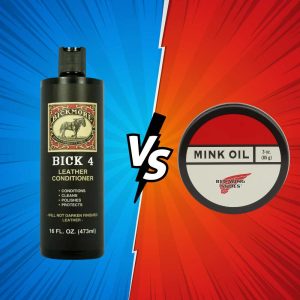Winter will eventually come, and along with it will come cold and wet conditions that won’t be the best for your leather boots.
A pair of damp, freezing socks can spoil your whole day in a matter of seconds on a nice winter day. But do you know what else is annoying in cold weather? Moisture seeping into your boots is bad news because it leads to discomfort and sometimes even blisters. But the good thing is, soggy feet will be a thing of the past if you correctly seal your boots.
Many people think that leather boots can’t be waterproofed. But it’s a wrong notion. Waterproofing leather boots is very much possible. Now, leather boots may not be waterproofed to the same extent as rubber boots, but you can waterproof them well enough to cope in any harsh environment.
To preserve the long-term viability of your purchase of leather boots, it’s a must to know how to waterproof them. So, if you’re a leather boot owner, now is your time to get your hands dirty because you can seal your leather boots very easily by yourself, and I have everything you need to know to do so.
How to Prep Your Boots Before You Start the Sealing Process
There’s a high possibility that your boots, whether they’re for trekking, working, or hiking, already have a basic waterproofing coating on them. But you have to seal your boots to ensure their longevity.
How frequently you waterproof your boots will depend on how frequently you wear them. Your boots can be waterproofed pretty much anytime they become particularly filthy or water no longer beads up on the surface. But it’s suggested you seal your boots once every couple of months to maintain their longevity.
Related: Smoke-Free Feet: How to Get Smoke Smell Out of Leather Shoes
Before you begin to waterproof your boots, it’s vital that you identify what material they are made of. When it comes to waterproofing, there is a specific product for each kind of material. For example, boots made of full-grain leather can require a different care regimen than those made of nubuck or suede leather.
If you’re ever unsure about the materials used to make your boots, a quick visit to the manufacturer’s website will clear things up.
Waterproofing your leather boots will begin with breaking them in. If your boots have not yet been broken in, you must break them in before starting the waterproofing.
After that, you need to thoroughly clean your boots. The waterproofing solution may well be hindered by grime and dirt, preventing the treatment from completely covering the boots. So, to make sure your boots last as long as possible, make sure they are kept clean at all times.
Get rid of any dust or filth by taking off the laces. Placing your boots in an inch of water can help release the dirt off the bottom of your boots. If you still see any remaining dirt, you can easily remove it by spraying the dirt away with a hose.
You can then return to your boots when the upper is still moist but not completely dried. It will help the leather better penetrate the treatment.
Related: Save Your Shoes: Learn How to Clean Leather Insoles
Starting the Sealing Process
After your boots are prepped properly, it’s now time to start the sealing/waterproofing process. Use the correct product depending on the kind of boots you’re working with. You can apply several kinds of waterproofing solutions in various ways:
Wax
If you’re sealing suede leather boots, wax is the way to go. For leather and suede boots, wax is the ideal choice. The use of wax as a sealant is an old practice that offers a number of benefits. It is more of a comprehensive process, but it is truly beneficial when it comes to sealing your entire boot, with the exception of newer boots or boots that have just been re-soled.
Natural beeswax is by far the most common kind of wax used by people, and it is sold in a wide variety of retail, agricultural, and leather stores. You can easily find it online too.
Related: Gum Emergency? Learn How to Remove Gum from Leather Shoes Quickly
Reheat the wax with a hairdryer before you start applying it. Rub the wax all over the boots and make sure you reach all the cracks and crevices. It’s ideal to use your fingertip when you seal your boots with wax.
After applying the coating, reheat the boots until they are warm but not too hot, then use your fingertips to level out any lumpy spots. Let the boot come to room temperature and set in a hot, dry location for a whole day.
Remove the remaining wax and polish for a brilliant gloss. Waxing is a tedious procedure, but it’s excellent at getting into the cracks and crevices of the surface.
Creams
There are a lot of experienced outdoorsy people who have become experts at waterproofing boots, and the majority of their choices with their sealing techniques originate from conventional methods using organic materials.
A very conventional approach is to make use of a cream known as lanolin, which is produced from the oil of sheep’s wool. It is a purely organic product that experts have used for centuries to waterproof leather.
To waterproof your boots using cream, start by massaging the cream with the help of the applicator provided or a piece of clean cloth. If your boot has a difficult-to-reach crevice, use a dry cloth to wipe it out.
Oils
Oils can be applied to a wide range of boots to seal away dampness and extend the life of the footwear. If leather boots are to be waterproofed with oils like fur or mineral, make sure they’re not over-applied.
The oils can cause the cowhide fibers to split and darken if they are over-applied. Using a soft cloth with a modest quantity of oil on it, uniformly coat the boot with the oil.
Spray
Spray is a popular choice for waterproofing boots when you want an easier process. Sprays are very easily accessible as well. You can get silicone polymer spray both in stores and online.
Before you spray your boots, you need to prepare them adequately. The shafts of the boots can be kept straight while being sprayed and dried by putting folded newspaper in the opening of the boots.
After the boots are dry and cleaned, it is time to begin spraying. Secure the entire area by laying down the newspaper and reading the instructions. It’s best to hold the sprayer at least eight to twelve inches away from your face and to direct it away from your face while using it. This will ensure a clear and consistent spray every time.
After you’re done spraying, you can go for a second spray if you deem it necessary. A reapplication of this form of sealing is required when your boots are exposed to wet conditions multiple times in a row.
Finish off by Drying the Boots
Following the application of the treatment, it will take some time for your boots to fully dry out. Put them in a spot that has the right temperature, mild humidity, and enough air circulation. People often use direct heat, like a hair dryer, to hurry up the speeding process. But I suggest you never do that since this might cause the glue on your boots to come free or cause the leather to crack. It is also recommended that you do not dry your boots in direct sunlight.
Nevertheless, if you really need to speed up the process, you can do so by using a fan to help circulate the air. One useful approach to retaining moisture, and one that is especially helpful when it comes to helping to dry the insole of the boot, is to stuff the boots with balls of crumpled-up newspapers.
After you have washed, conditioned, and dried your boots, they will be in tip-top shape and be ready for you to put them on and walk confidently and comfortably. It’s time to now put them on and give yourself a pat on the back for successfully finishing the process.
Repeating the Sealing Process
When it’s time to apply another coat of sealant to your leather work boots, you’ll know by looking at them. because the coat of polish will be clearly visible. But keep in mind that, You have to wait until your boots are completely dry and clean before starting the sealing process again.
If you use silicone spray to waterproof your boots again, there will be darker and moistened parts of the leather after using silicone spray. Because a lack of sealing means the boots have started to soak up water again. Make sure to let the fresh spray completely dry, and you’ll be good to go.
When it comes to wax, scuffing, and drying of the leather are two signs that your boots need to be waxed again. You’ll notice it, as the beeswax on top wears away. In such a case, just repeat the process and add a fresh coat of wax to the boot on top. Let it dry, then buff it off, and you’re good to go.
When it comes to oil sealing, you’ll notice it’s time to waterproof again when your boot loses its shine. If your boots come into contact with water a handful of times after sealing, it’s time to waterproof them again.
Make sure to not waterproof your boots just once, but continue the sealing process over time to ensure the longevity of your leather boots.
FAQ
Is vaseline bad for leather?
Yes. This is a concern and confusion of many people. To add to the confusion, there are many different types of petroleum products, each with its own unique name and function. But the answer is that using Vaseline or any kind of petroleum will degrade leather because it dries the leather out by removing its natural oils.
How long does waterproof last?
It depends on how well-made the boots are and how often you use them. However, from what I’ve seen, the majority of waterproof membranes in leather boots will fail within one to two years of regular usage at the very most.
Can rain ruin leather boots?
It certainly does. Under some circumstances, leather boots can become wet to the point of saturation without causing any irreversible damage. If you’re in an area where it rains a lot and your leather boots come into contact with the rain a lot, you need to consider purchasing a waterproof boot or waterproof boots yourself.
Is it okay to polish leather boots?
You most definitely can polish your leather boots. To maintain the brand-new look of your leather boots, you should make an effort to polish them on a daily basis and keep them dry as much as you can.
Conclusion
There you have it! I’m sure by now you have a good idea about sealing your leather boots. Sealing or waterproofing your boots is an excellent place to start when it comes to foot care. This process will keep your feet safe but also make your favorite leather boots last longer for years to come. So, now that you have everything you need to know, it’s time to get to work!

